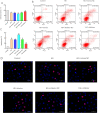The role and mechanism of action of miR-483-3p in mediating the effects of IGF-1 on human renal tubular epithelial cells induced by high glucose
- PMID: 38972889
- PMCID: PMC11228025
- DOI: 10.1038/s41598-024-66433-y
The role and mechanism of action of miR-483-3p in mediating the effects of IGF-1 on human renal tubular epithelial cells induced by high glucose
Abstract
This study aimed to elucidate the influence of miR-483-3p on human renal tubular epithelial cells (HK-2) under high glucose conditions and to understand its mechanism. Human proximal tubular epithelial cells (HK-2) were exposed to 50 mmol/L glucose for 48 h to establish a renal tubular epithelial cell injury model, denoted as the high glucose group (HG group). Cells were also cultured for 48 h in a medium containing 5.5 mmol/L glucose, serving as the low glucose group. Transfection was performed in various groups: HK-2 + low glucose (control group), high glucose (50 mM) (HG group), high glucose + miR-483-3p mimics (HG + mimics group), high glucose +miR-483-3p inhibitor (HG + inhibitor group), and corresponding negative controls. Real-time quantitative polymerase chain reaction (qPCR) assessed the mRNA expression of miR-483-3p, bax, bcl-2, and caspase-3. Western blot determined the corresponding protein levels. Proliferation was assessed using the CCK-8 assay, and cell apoptosis was analyzed using the fluorescence TUNEL method. Western blot and Masson's staining were conducted to observe alterations in cell fibrosis post miR-483-3p transfection. Furthermore, a dual-luciferase assay investigated the targeting relationship between miR-483-3p and IGF-1. The CCK8 assay demonstrated that the HG + mimics group inhibited HK-2 cell proliferation, while the fluorescent TUNEL method revealed induced cell apoptosis in this group. Conversely, the HG + inhibitor group promoted cell proliferation and suppressed cell apoptosis. The HG + mimics group upregulated mRNA and protein expression of pro-apoptotic markers (bax and caspase-3), while downregulating anti-apoptotic marker (bcl-2) expression. In contrast, the HG + inhibitor group showed opposite effects. Collagen I and FN protein levels were significantly elevated in the HG + mimics group compared to controls (P < 0.05). Conversely, in the HG + inhibitor group, the protein expression of Collagen I and FN was notably reduced compared to the HG group (P < 0.05). The dual luciferase reporter assay confirmed that miR-483-3p could inhibit the luciferase activity of IGF-1's 3'-UTR region (P < 0.05). miR-483-3p exerts targeted regulation on IGF-1, promoting apoptosis and fibrosis in renal tubular epithelial cells induced by high glucose conditions.
Keywords: High glucose; IGF-1; Kidney injury; Renal tubular epithelial cells; miR-483-3p.
© 2024. The Author(s).
Conflict of interest statement
The authors declare no competing interests.
Figures






References
-
- Satirapoj B, Pooluea P, Nata N, Supasyndh O. Urinary biomarkers of tubular injury to predict renal progression and end stage renal disease in type 2 diabetes mellitus with advanced nephropathy: A prospective cohort study. J. Diabetes Complicat. 2019;33:675–681. doi: 10.1016/j.jdiacomp.2019.05.013. - DOI - PubMed
MeSH terms
Substances
Grants and funding
LinkOut - more resources
Full Text Sources
Molecular Biology Databases
Research Materials
Miscellaneous

